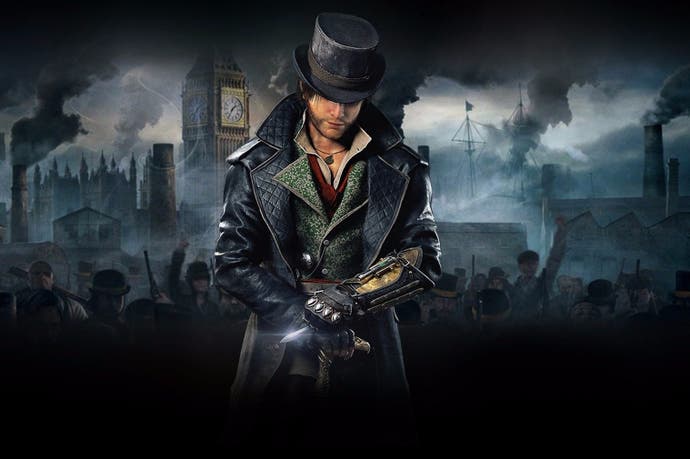Assassin's Creed Syndicate time-lapse: world in motion
Victorian London - as simulated by PlayStation 4.
Time of day dynamic lighting has returned to the Assassin's Creed series in its latest outing - and we thought we'd make the most out of it. Over the course of the last week, one of our PlayStation 4s has been attached to a spare capture system, patiently recording time-lapse video of Victorian London while we busy ourselves with other tasks. It's been a fascinating experience - exploring an environment we know so well, finding key locations and comparing Ubisoft's renderings of 1868 with our own knowledge of the city 147 years later.
It's an often uncanny facsimile of Britain's capital but of course, there are cut-backs and compromises in the game architecture. Necessarily, the city is made smaller and more navigable, with some key locations relocated or omitted as a result. Oxford Street - a part of London in some shape or form since Roman times - doesn't seem to make the cut. Nearby Regent Street is also missing, though Piccadilly Circus is present, looking very different to its present day incarnation. Liverpool Street station is absent, St Pancras is a stone's throw from Trafalgar Square and the Animus' map falls just short when it comes to allowing acces to the Tower of London, and of course the iconic Tower Bridge had yet to be build in Syndicate's 1868 timeframe. This is London then, but even long-term city dwellers may end up confused by Ubisoft's gamification of the map.
But what's there remains a remarkable achievement: seven boroughs' worth of intricate detail, complete with a range of world famous landmarks - many of them just as you remember them from any given 21st century visit. Others are very different, yet still oddly familiar. Buckingham Palace had yet to receive its 1913 facelift, while Leicester Square only hints at the entertainment centre it was to become. Ubisoft had just one shot at getting London right and by and large, the developers have done a fantastic job - the irony being that it's the renderings of the less charted streets in the poorer boroughs that give us more of an indication of what life as actually like back then for the vast majority of the 3.2m population.
So, onto the time-lapse. There were no shortcuts here - it was a case of choosing our shots, setting off a 10fps capture then coming back anything up to two hours later to see how we'd got on. Street-level shots proved challenging owing to the gang members populating each borough - if they got a look at you, it's effectively game over and getting the Palace of Westminster shot at 2:13 proved particularly troublesome for this reason. Few shots gave us a perfectly still viewpoint either, essential for time-lapse video. Positioning Jacob next to a piece of scenery and turning the camera removes him from the picture, but the view continues to wobble slightly. Thankfully Adobe Premiere Pro's warp stabiliser filter (designed to minimise camera shake) managed to sort out most of the shots we'd captured. Sometimes we got lucky - the lovely opening shot, taken from the summit of the Monument to the Great Fire of London to the east of St Paul's, didn't require any correction - and the subtle pan downwards occurred entirely by luck.
On a technical level, Ubisoft's approach to time of day lighting is fascinating. A full 24-hour cycle in Assassin's Creed Unity seems to take around half an hour to complete, but various tricks and tweaks are employed to ensure that players spend as much time in daylight as possible. Sunrise is at 5am with the sun setting at 6pm. However, outside of that window, time literally seems to pass twice as quickly - there are plenty of working clocks in the time-lapse, so you can see that for yourself, starting 23 seconds in with the Westminster Abbey shot. Also odd is that 5am sees the time of day system temporarily pause: atmospheric rendering continues apace, but in-game clocks and even the sun itself remain static for a few moments before the day is allowed to recommence.
Accelerating the passage of time also gives us some idea of the quality of the overall world simulation, particularly in regards to NPC behaviour and vehicle AI. We shouldn't expect too much attention to detail here - but the population of Syndicate's London do react to adverse weather, random fights can break out when the gang members get unruly and there is actually a functional police force - but the overall intelligence level is low, characters happily walk into scenery and vehicle drivers can sit about for hours or even days on end doing nothing at all when a rogue NPC stands in front of them.
Overall, Ubisoft's Victorian playground is beautifully rich in detail and for the purposes of its gameplay, the simulation of city is good, though shallow enough to see through - even without time-lapse video. There's the sense that the digital Londoners seen here are little more than decoration really, and that's fine as far as it goes, but sometimes video games can surprise us in their level of sophistication. Revisit our GTA 4 time-lapse and while you'll see a generational regression in NPC count and distance visibility, the ambition in their behaviour is self-evident - the citizens reaching for their umbrellas when it rains, taking a morning jog, grabbing a coffee, reading a newspaper. It's nothing like a complete simulation of city life, but the more realistic, context-sensitive behaviours add a layer of authenticity unseen in other open world titles - and bizarrely, that even includes its own sequel.
We had a lot of fun putting this together. Part of the appeal was in checking out just how far Ubisoft has come with its world rendering technology. But over and above that, London is our manor, and the game offers us the opportunity to step back in time and to see our everyday world through a different lens. Assassin's Creed Syndicate is well worth picking up for its gameplay credentials, but for those who know the city, there's a unique appeal in exploring Ubisoft's recreation of our past - glorious and dreadful in equal measure.
- Download a high quality version of this video [right-click, save as] or grab the mirror.










